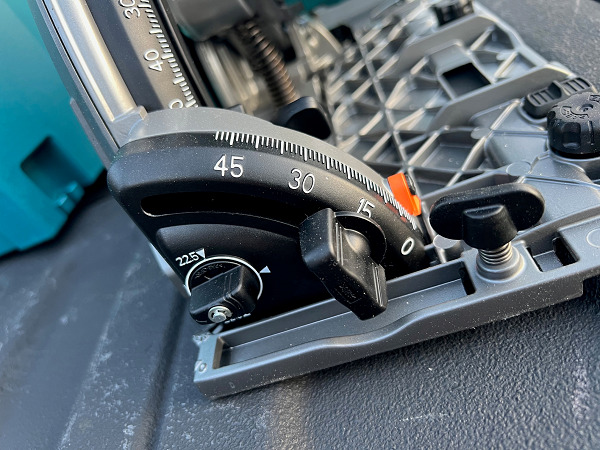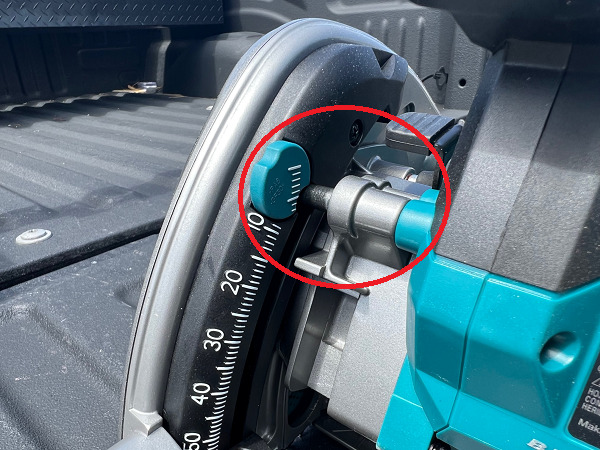Makita 40V Cordless Plunge Saw Review
Makita 40V XGT 6-1/2″ Cordless Plunge Saw Kit Review – Model GPS01M1J
Makita GPS01M1J1 40v 6-1/2" Plunge Saw Kit
A plunge saw (also referred to as Track Saw – which will happen many times in this article) may be a better alternative than a circular saw but it all depends on what you want to do with your saw. A plunge saw offers a number of advantages, but it also has some disadvantages. Plunge saws and track saws are two terms that are used interchangeably. The blade is hidden beneath the saw’s huge dust shield while not in use. You can dial in the depth of the cut before cutting, and then plunge the blade into the wood to that depth. This plunge feature aids rip out, but it also means you can use the saw to do cuts that you would normally need a jigsaw for, such as cutting out a template for a sink in a countertop.

Makita GPS01M1J Kit
The Makita GPS01M1J Kit consists of the following item:
- GPS01Z – 6-1/2″ Brushless Plunge Saw
- BL4040 – 40V XGT 4.0Ah Battery
- DC40RA – Rapid Optimum Charger
- B-57342 – 6-1/2″ 56T Plunge Saw Blade
- 783203-08 – Onboard Hex Wrench
- 197210-9 – MAKPAC Interlocking Small Case
- 197213-3 – MAKPAC Interlocking X-Large Case
Makpac Interlocking Cases
The Makita Plunge Saw Kit comes with two Makita’s Makpac interlocking cases which allow you to keep all your items together. The small case has a nice plastic insert so your charger and batteries stay secure.

The X-Large interlocking case houses the Plunge Saw. There is a plastic mold on the bottom that keeps the saw from moving around.

Makita Plunge Saw Tracks
Not included in the Makita plunge saw track, model GPS01M1J. You would think that the saw and track go hand and hand but Makita does not include the track in the Plunge Saw Kit. Makita offers tracks in three sizes.
- 39″ – Model 199140-0: Price $69.99
- 55″ – Model 194368-5: Price $90.99
- 118″ – Model 194367-7: Price $219.99
Makita Guide Rail Connector
There is a significant price difference between the 55″ and the 118″ track. A lot of pro contractors will purchase two 55″ tracks and use Makita’s Guide Rail Connector Kit (model P-45777), which costs about $25.00. This will make the cost roughly the same however it allows for much better storage. It is far easier to store two 55″ tracks than it is to store a 118″ track.
The Guide Rail Connector Kit is easy to install and lined up the two tracks perfectly allowing for a long straight cut.

When finished with the dual-track cut, you can store the guide rail connector securely in the second track so you will not lose it or in the provided tube and store it in the Makpac with the saw.

Makita Plunge Saw Specifications
- Blade Diameter: 6-1/2″
- Arbor: 20 mm
- Max. Cutting Capacity (at 90°) : 2-3/16″
- Max. Cutting Capacity (at 45°) : 1-9/16″
- No Load Speed: 2,500 – 4,900 RPM
- Battery: 40V max XGT® Lithium-Ion
- Automatic-start Wireless System (AWS™): Capable (transmitter sold separately)
- Bevel capability (-1º to 48º) with positive stops at 22.5º and 45º
- Soft start feature for smooth start-ups
- Electric brake
- Large 1-7/16″ rear dust port
- Built-in depth stop
- Auto-start Wireless System (AWS®) – wireless on-off communication between the tool and dust extractor – Chip Sold Separately
- Dual front and rear bevel supports
Making Straight Accurate Cuts
We often refer to cuts that need to be super accurate as “money cuts”. These cuts can be on highly expensive cabinets, cutting down doors to size, or cutting down custom-made benchtops. There is no room for errors on these cuts. Errors cost you money by having to replace the piece you miscut. Plunge cuts are the way to go when needing to make these money cuts.

Using the Makita plunge saw to make some custom shelves. The saw is easy to use and has a great plunge motion. The plunge motion is a very natural bending of the wrist, versus other competitors where you have to push down on the saw to get it to drop.
Auto-Start Wireless System (AWS)
The AWS system (Auto-Start Wireless System) is a Bluetooth technology that allows dust extractors with the AWS system to turn on and off wirelessly. A tiny wireless transmitter is placed into the handle of Makita AWS-equipped equipment. A Makita dust extractor with an AWS transmitter can communicate with the transmitter. When the AWS-equipped GPS01Z’s trigger is pressed, the AWS-equipped dust extractor activates. The dust extractor turns off when the trigger is released.

The AWS-equipped tool can also communicate with ANY corded dust extractor with an onboard AC outlet and the optional Makita AWS Universal Adaptor. The adapter has an AWS wireless transmitter and plugs into the dust extractor’s onboard AC outlet. The transmitter and adapter are optional and do cost more money but the convenience, long-term time savings, and efficiency make it an investment worth considering.
Dust Port
One issue we didn’t like is the dust port is different than other Makita tools we have and it does not fit some of their vacuums, specifically my Makita XCV23Z 36v cordless dust extractor.
We recommend that Makita us a standard diameter dust port, or provide an adapter compatible with all their extractors that would make hooking up a lot easier. Having to rig up some random adapters to get good dust extraction is not the most practical way.

Bevel Adjustments

Depth Adjustment
With built-in depth stops, you are provided with an easy depth adjustment for clean and accurate cutting. We wish that the depth scale was in INCH rather than MM. The full depth of this saw is 56mm (2-3/16″)
- 10MM – roughly 3/8″
- 20MM – roughly 3/4″
- 30MM – roughly 1-3/16″
- 40MM – roughy 1-9/16″
- 50MM – roughly 1-15/16″

Bevel Adjustment
Bevel knobs are located on both the front and back of the saw. Dual front and rear bevel support add strength for precise and accurate bevel cuts, but the rear bevel is often overlooked, leaving you wondering why the shoe plate isn’t moving. The positive stopper is important for quickly determining the desired angle. Turn the positive stopper so the arrow points 22.5 °. Loosen the front and back clamping screws. Then tilt the blade until it comes to a halt, and use the clamping screws to attach the base.

Blade Change Lever Locking Mechanism
The blade change locking lever holds the blade in position so that the wrench can be inserted through the hole in the blade case for easier blade installation.

Once engaged the plunge mechanism is locked and makes it easier to press the arbor lock and use the provided hex key to change out the blade. The hex key is stored tightly on the bottom of the handle near the dust port.

Conclusion
When it comes to creating precise cuts, a track saw is unrivaled. It can perform about everything a table and circular saw can do, and it’s a lot more portable and accurate than a table saw. It also breaks down large sheets of plywood better and safer than a table saw. A track saw, on the other hand, may be quite costly, so make sure it’s the correct tool for your needs before you acquire one. DIYer or hobbyist who is just getting started, perhaps a circular saw with a jig is a wiser investment, but if you are making “money cuts” on expensive doors, cabinets, or expensive sheet goods, for example, you won’t be disappointed.
About the author
1 Comment
Leave a comment
Disclosure
Product reviews on this site contain our opinion of a product or service. We will always strive for objectivity and transparency in our reviews. Our goal is to provide readers with honest, objective information based on our own experiences. We never have and never will accept payment in exchange for a positive review. Many of the products that we review are provided to us for free by a manufacturer or retailer. In some cases, we also have advertising or affiliate relationships with manufacturers and retailers of products and services we review. For additional information please visit our additional disclosure policies.

























It would be nice to compare this to the 36V Makita track saw. We prefer those to Festool, DEWALT, etc. Does the 40V version have any great advantages. The 36 V version works great with Festool and Bosch vacuum/dust collector hoses, I suspect this one does too. It becomes quite easy to convert metric to inch once you do it a few times; good brain exercise.